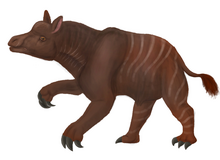| Tylocephalonyx Temporal range: Miocene,
| |
|---|---|

| |
| Life restoration | |
| Scientific classification | |
| Domain: | Eukaryota |
| Kingdom: | Animalia |
| Phylum: | Chordata |
| Class: | Mammalia |
| Order: | Perissodactyla |
| Family: | †Chalicotheriidae |
| Subfamily: | †Schizotheriinae |
| Genus: | †Tylocephalonyx Coombs, 1979 |
| Species: | †T. skinneri
|
| Binomial name | |
| †Tylocephalonyx skinneri Coombs, 1979
| |
Tylocephalonyx (Greek: "knob" (tylos), "head" (kephalos), "claw/hoof" (onyx)[2]) is an extinct chalicothere from the Miocene of North America.
Description
Tylocephalonyx specimens are notable for a dome-shaped skull, a feature found in some other schizotheriine chalicotheres but most developed in this genus. Adequate fossil material is lacking to tell whether both sexes had domed heads, but sexual dimorphism was common in the group. Tylocephalonyx may have used its "dome" in the same way as the pachycephalosaurs, though there is no clear evidence to link either pachycephalosaurs nor Tylocephalonyx to using their domes to crash together in high-impact head-to-head contests, as in modern bighorn sheep. Such contests require special cranial adaptations to protect the brain and cervical spine, not shown in chalicotheres. The dome of Tylocephalonyx may have been used for visual display or in butting or head-to-body battering contests.[3]
See also
References
- ^ "Tylocephalonyx in the Paleobiology Database". Fossilworks. Retrieved 17 December 2021.
- ^ "Glossary. American Museum of Natural History". Archived from the original on 20 November 2021.
- ^ Munthe, Jens; Coombs, Margery C. (1979). "Miocene Dome-Skulled Chalicotheres (Mammalia, Perissodactyla) from the Western United States: A Preliminary Discussion of a Bizarre Structure". Journal of Paleontology. 53 (1): 77–91. ISSN 0022-3360. JSTOR 1304036.
Sources
- National Geographic Prehistoric Mammals (National Geographic) by Alan Turner
- After the Dinosaurs: The Age of Mammals (Life of the Past) by Donald R. Prothero
- Classification of Mammals by Malcolm C. McKenna and Susan K. Bell
- Late Cretaceous and Cenozoic Mammals of North America: Biostratigraphy and Geochronology by Michael O. Woodburne
- Colbert's Evolution of the Vertebrates: A History of the Backboned Animals Through Time by Edwin H. Colbert, Michael Morales, and Eli C. Minkoff
- Coombs, Margery C. (1979). "Tylocephalonyx, a new genus of North American dome-skulled chalicotheres (Mammalia, Perissodactyla)". Bulletin of the AMNH. 164 (article 1). American Museum of Natural History: 1–64. hdl:2246/1041.

